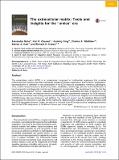| dc.contributor.author | Clauser, Karl R. | |
| dc.contributor.author | Carr, Steven A. | |
| dc.contributor.author | Naba, Alexandra | |
| dc.contributor.author | Ding, Huiming | |
| dc.contributor.author | Whittaker, Charles A. | |
| dc.contributor.author | Hynes, Richard O. | |
| dc.date.accessioned | 2017-02-15T15:20:59Z | |
| dc.date.available | 2017-02-15T15:20:59Z | |
| dc.date.issued | 2015-06 | |
| dc.date.submitted | 2015-07 | |
| dc.identifier.issn | 0945-053X | |
| dc.identifier.uri | http://hdl.handle.net/1721.1/106936 | |
| dc.description.abstract | The extracellular matrix (ECM) is a fundamental component of multicellular organisms that provides mechanical and chemical cues that orchestrate cellular and tissue organization and functions. Degradation, hyperproduction or alteration of the composition of the ECM cause or accompany numerous pathologies. Thus, a better characterization of ECM composition, metabolism, and biology can lead to the identification of novel prognostic and diagnostic markers and therapeutic opportunities. The development over the last few years of high-throughput (“omics”) approaches has considerably accelerated the pace of discovery in life sciences. In this review, we describe new bioinformatic tools and experimental strategies for ECM research, and illustrate how these tools and approaches can be exploited to provide novel insights in our understanding of ECM biology. We also introduce a web platform “the matrisome project” and the database MatrisomeDB that compiles in silico and in vivo data on the matrisome, defined as the ensemble of genes encoding ECM and ECM-associated proteins. Finally, we present a first draft of an ECM atlas built by compiling proteomics data on the ECM composition of 14 different tissues and tumor types. | en_US |
| dc.description.sponsorship | National Cancer Institute (U.S.) (Tumor Microenvironment Network. Grant U54 CA126515/CA163109) | en_US |
| dc.description.sponsorship | Broad Institute of MIT and Harvard | en_US |
| dc.description.sponsorship | National Cancer Institute (U.S.) (David H. Koch Institute for Integrative Cancer Research at MIT. Support Grant P30-CA14051) | en_US |
| dc.description.sponsorship | Howard Hughes Medical Institute (Postdoctoral Fellowship) | en_US |
| dc.description.sponsorship | Ludwig Center for Molecular Oncology at MIT (Postdoctoral Fellowship) | en_US |
| dc.language.iso | en_US | |
| dc.publisher | Elsevier | en_US |
| dc.relation.isversionof | http://dx.doi.org/10.1016/j.matbio.2015.06.003 | en_US |
| dc.rights | Creative Commons Attribution-NonCommercial-NoDerivs License | en_US |
| dc.rights.uri | http://creativecommons.org/licenses/by-nc-nd/4.0/ | en_US |
| dc.source | Elsevier | en_US |
| dc.title | The extracellular matrix: Tools and insights for the “omics” era | en_US |
| dc.type | Article | en_US |
| dc.identifier.citation | Naba, Alexandra et al. “The Extracellular Matrix: Tools and Insights for the ‘omics’ Era.” Matrix Biology 49 (2016): 10–24. CrossRef. Web. | en_US |
| dc.contributor.department | Massachusetts Institute of Technology. Department of Biology | en_US |
| dc.contributor.department | Koch Institute for Integrative Cancer Research at MIT | en_US |
| dc.contributor.mitauthor | Naba, Alexandra | |
| dc.contributor.mitauthor | Ding, Huiming | |
| dc.contributor.mitauthor | Whittaker, Charles A. | |
| dc.contributor.mitauthor | Hynes, Richard O. | |
| dc.relation.journal | Matrix Biology | en_US |
| dc.eprint.version | Final published version | en_US |
| dc.type.uri | http://purl.org/eprint/type/JournalArticle | en_US |
| eprint.status | http://purl.org/eprint/status/PeerReviewed | en_US |
| dspace.orderedauthors | Naba, Alexandra; Clauser, Karl R.; Ding, Huiming; Whittaker, Charles A.; Carr, Steven A.; Hynes, Richard O. | en_US |
| dspace.embargo.terms | N | en_US |
| dc.identifier.orcid | https://orcid.org/0000-0001-7603-8396 | |
| dspace.mitauthor.error | true | |
| mit.license | PUBLISHER_CC | en_US |
